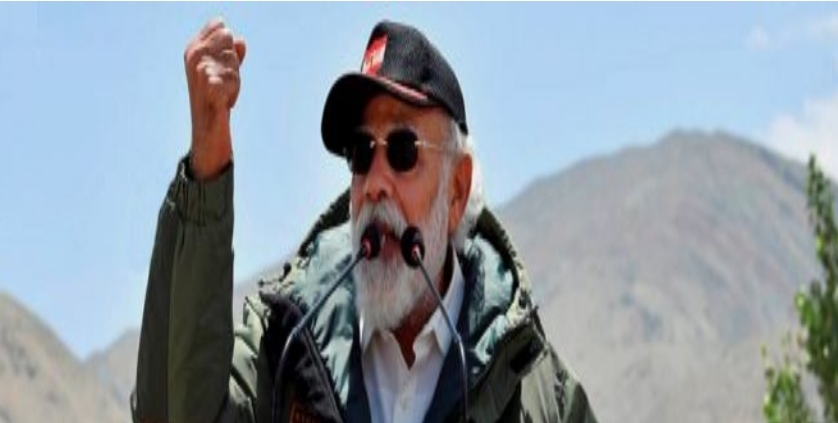India’s Posture On China Must Match New Realities At LAC

India should identify places where our forces have tactical advantage that can enable them to take back occupied territory from the Chinese
by Shyam Saran
The public perception the Narendra Modi government is seeking to create is that the crisis on the Line of Actual Control in eastern Ladakh has been defused; that the Chinese have been stopped in their tracks through a determined riposte by the Indian armed forces and compelled to climb down from their aggressive and arrogant posture; that the Prime Minister’s stern message delivered during his visit to Ladakh has been the turning point in persuading the Chinese to choose the path of disengagement and de-escalation. These are dangerous illusions not based on any objective assessment of an entirely new situation we are facing, not only in select areas at the LAC, but in the whole context of India-China relations.
India Should Mind The ‘Gap’ And Move
The projection of China’s meek bowing to Indian display of force and resolve is not believable. There is deep asymmetry of both infrastructural and hardware capabilities in favour of China and this is all along the LAC in west, centre and the east, and this asymmetry is growing. China is conveying that it can create trouble for India where and when it chooses to, keeping us off-balance, or to put it in another way, keep us in line. India should be mindful of the threat not just at this or that stretch but all along the LAC. One could identify places where our forces have tactical advantage that could enable our side to nibble away the Chinese territory( take back areas of Chinese Occupied Ladhak ), just as they have been doing to us for years. One would then have something to bargain with when Chinese transgressions take place. This requires highly mobile and well-trained forces along with a proactive mindset.
I have seen neither evidence of us raising such forces nor of having this in our SOPs. Even if we were able to engage in tactical offence, the reality of power asymmetry puts us overall on the strategic defensive. If disengagement does take place and the status quo ante is restored—which I seriously doubt—the lesson to be drawn is not that we have managed to awe the Chinese to step back but rather that they believe their objectives have been achieved through this display of force.
Problem With Buffer Zones
If disengagement entails going back from their current positions about a couple of kilometres, this may not mean much since China can amass large forces at the LAC in much shorter periods compared to us. If de-escalation occurs and the rear forces, armaments and even semi-permanent or permanent structures are dismantled and moved further back, this, too, has little meaning precisely for the same reason. Chinese infrastructure makes mobilisation time much faster than on the Indian side. Tensions can be ratcheted up or down as and when required by the Chinese. Only a risky gamble of a surprise operation at a point of our choosing on the LAC could have shifted the onus of escalation on to the Chinese, and given them a pause. The Chinese do not like surprises and usually pause to reflect and reassess before taking further actions. But that moment has passed.
The Chinese side will not engage in a major military offensive against India because it is not necessary to achieve the political objective of keeping India preoccupied on its borders. Its current series of actions are of a piece with China’s deepening alliance with Pakistan and its steady inroads into our periphery to the north and south.
From China’s perspective, escalation control becomes more difficult as the scale of the offensive expands, particularly against a substantial, well-trained and highly motivated force, which the Indian armed forces undoubtedly are. There is risk of escalation to the nuclear threshold. This may also bring in other major powers into the equation which will add to uncertainties. So, I do not expect such escalation. However, India needs to be honest and objective about its present predicament and devise an appropriate counter-strategy. We should avoid obfuscating the situation by using terms like “buffer zones”, “zones of disengagement” or “differences in perception of the LAC” which deflect attention from the reality of a new LAC having come into existence in some of the contested areas.
If Indian troops have to withdraw from areas on our side of the LAC to create such “buffer zones”, if they have to suspend patrols to avoid clashes, then we would have acquiesced in the Chinese ‘two steps forward one step back’ tried and tested playbook.
Lessons From The Stand-Off
In the short-term, there will have to be a serious consideration of asymmetrical and tactical measures to raise the risk and cost of continued Chinese transgressions. There has to be an acceleration of our border infrastructure building just as it took place after the 1962 debacle. The Border Roads Organisation was set up and chaired by a Prime Minister — Jawaharlal Nehru, in 1960. We need to make a similar effort this time as well. This will convey a stronger signal of resolve than the morale-boosting and image-building visits to the border.
It is important for the government to take the people of India into confidence and share with them what the real situation at the border is even if that is currently discouraging. Any attempt to obscure ground reality due to misplaced domestic political compulsions or to shield the leader’s outsized public image, is fraught with even greater risk than the threat itself.
In these days of high-resolution satellites images and sophisticated intelligence gathering by friends and adversaries alike, our public posture or the lack of one, can be easily verified and assessed. The international credibility of the Indian state and its political leadership can be seriously undermined if posture does not match reality. This aggravates India’s vulnerabilities and undermines its ability to contribute credence and capability to the countervailing coalition, which must be a part of our external balancing strategy until we begin the hard work of building up our economic and security capabilities to shrink the glaring power gap with China.




